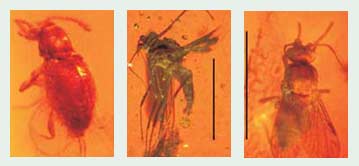Ecological diversity in amber in the Amazon region
The group of researchers led by Pierre-Olivier Antoine of Toulouse University (France) has discovered new invertebrate species preserved in amber from 12 to 15 million years near the Iquitos region in Peru, demonstrating Ecological diversity has been around for a long time in the Amazon region.

Two species of two-winged insects and a beetle worm
trapped in amber for at least 12 million years
(Photo: HTV)
The researchers identified 13 new insect groups and three new spider species trapped in amber along with pollen, algae or spores in very large numbers.
When the plastic layer becomes as hard as glass, it allows the preservation of insects that do not leave or leave very little traces of fossil bones in vertebrates.
Two other amber mines have been discovered in South America but this is the first time this mine has been found in the Amazon region. Iquitos region in northeastern Peru, near Brazil and Colombia. French researchers accidentally discovered this layer of amber on the banks of the Amazon River.
The total gate of 500g amber is taken from this area and is being analyzed. The discovery of many different species of organisms in a small amber sample demonstrates the abundance of biodiversity in this area during the Miocene period (from 5 million to 23.7 million years ago).
According to the researchers, the Amazon region may have been a tropical forest containing many ecosystems. The study was published in PNAS magazine.
WITH
- Ice mountains 'disrupt' ecological diversity in the Antarctic seabed
- Human remains 10,000 years ago at Amazon
- Ecological crisis threatens the Mekong sub-region
- Discovering millions of years of amber masses with great value
- The dragonfly trapped 100 million years in amber
- Discovered the dead body stuck in amber 99 million years
- The Amazon River hydropower project continues
- Forest fires and droughts can destroy the Amazon forest
- Found room amber inlaid gold 265 million?
- Detected 100 million year old chiseled amber contains group of 356 animals
- Climate change and flooding create biodiversity in the Amazon
- Found samples of amber weighing more than 2kg in Kaliningrad
 Is the magnetic North Pole shift dangerous to humanity?
Is the magnetic North Pole shift dangerous to humanity? Washington legalizes the recycling of human bodies into fertilizer
Washington legalizes the recycling of human bodies into fertilizer Lightning stone - the mysterious guest
Lightning stone - the mysterious guest Stunned by the mysterious sunset, strange appearance
Stunned by the mysterious sunset, strange appearance